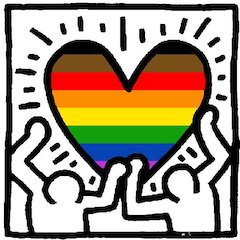
LGBTQ+ Art History. A section of art history that traces the creative expressions and cultural contributions of lesbian, gay, bisexual, transgender, queer, and other gender-diverse artists throughout the centuries. This field highlights how art has served as both a reflection of and a catalyst for social change, challenging norms and celebrating identities that have often been marginalized.
From ancient civilizations to the modern era, LGBTQ+ artists have played a pivotal role in shaping visual culture, influencing everything from classical sculpture to contemporary performance art.
Ancient to Early Modern Expressions
LGBTQ+ themes in art can be traced back to ancient Greece and Rome, where same-sex relationships and gender fluidity were depicted in pottery, sculpture, and frescoes. In the Renaissance, artists like Leonardo da Vinci and Michelangelo subtly incorporated homoerotic motifs and coded imagery into their works, reflecting both personal identity and societal constraints. These early representations laid the groundwork for later generations, even as LGBTQ+ lives were often hidden or suppressed.
The 19th and 20th Centuries: Visibility and Revolution
The 19th century saw the emergence of openly queer artists such as Oscar Wilde and Simeon Solomon, whose works challenged Victorian norms and celebrated same-sex desire. The early 20th century brought greater visibility, particularly in urban centers like Paris, New York, and Berlin. The Harlem Renaissance, for example, was a vibrant period for Black LGBTQ+ artists, including Richmond Barthé and Claude McKay.
The post-World War II era marked a turning point as LGBTQ+ artists became more vocal and visible. The Stonewall Uprising of 1969 ignited a wave of activism that profoundly influenced art. Artists like David Hockney and Robert Mapplethorpe explored themes of sexuality, identity, and community, often confronting censorship and controversy.
Contemporary LGBTQ+ Art
Today, LGBTQ+ art is celebrated globally, with artists addressing issues such as gender identity, intersectionality, and social justice. Zanele Muholi, a South African visual activist, documents the lives of Black LGBTQ+ individuals, while Catherine Opie explores queer identity through photography. Major museums and galleries now feature LGBTQ+ exhibitions, and Pride events often showcase queer artists.
Key Themes and Cultural Impact
LGBTQ+ Art History is characterized by resilience, innovation, and a commitment to authenticity. Common themes include love, resistance, transformation, and the search for belonging. The field continues to expand, embracing digital media, performance, and activism. By challenging stereotypes and amplifying marginalized voices, LGBTQ+ artists have reshaped the narrative of art history and inspired new generations.
Notable LGBTQ+ Artists
- da Vinci, Leonardo
- Hockney, David
- Michelangelo
- Muholi, Zanele
- Solomon, Simeon
- Tuke, Henry Scott
- Warhol, Andy
- Wilde, Oscar